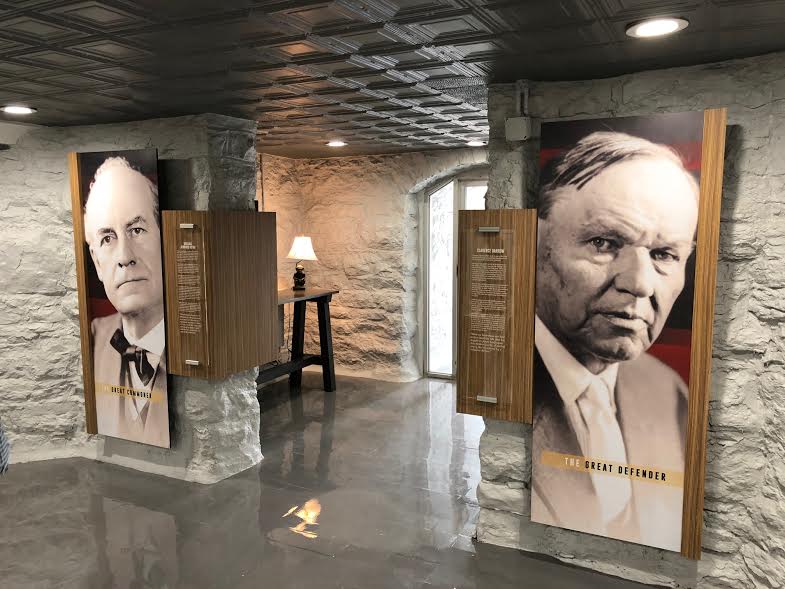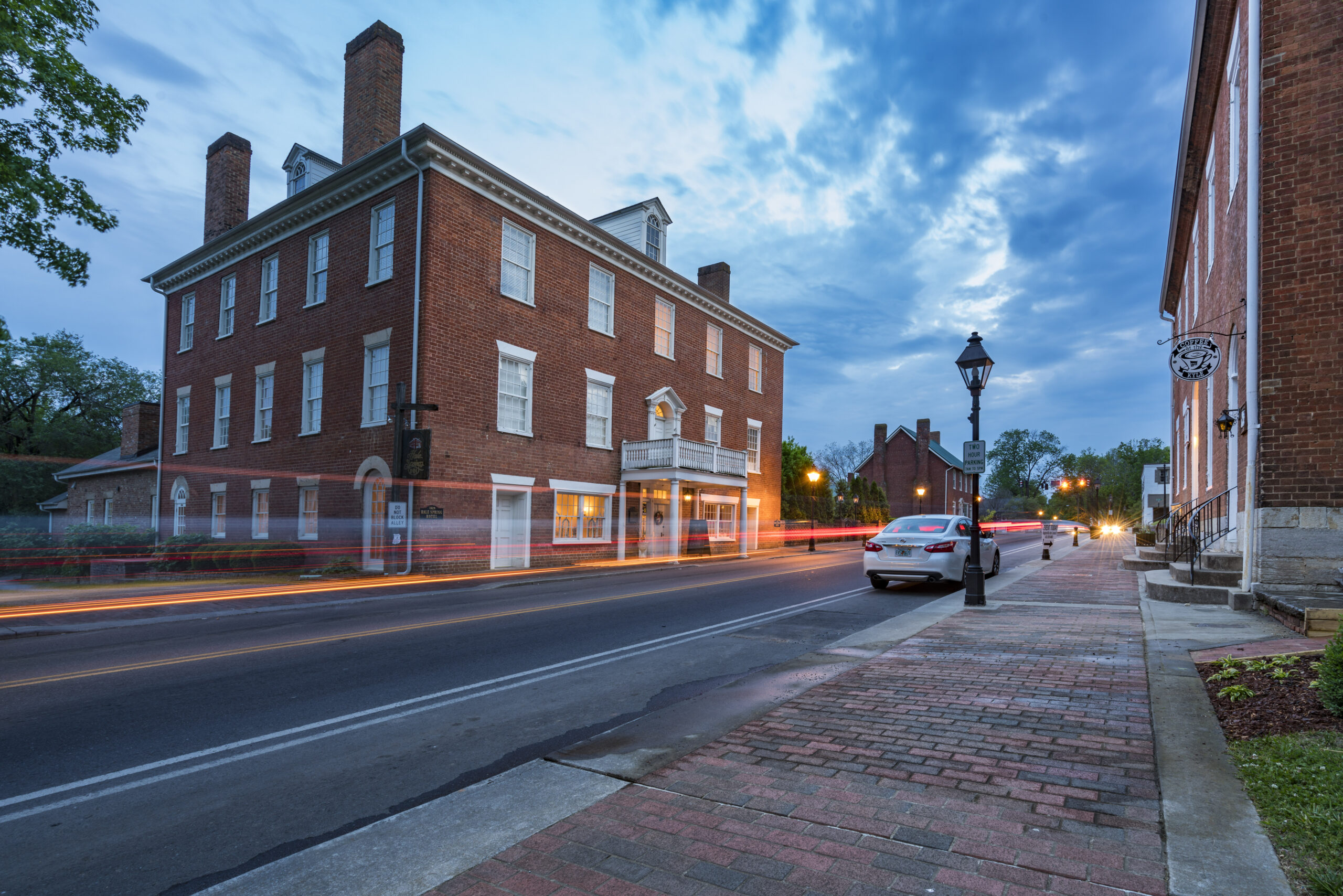Beginning in 1815 William Dickson, a wealthy Irish merchant and Greeneville’s first postmaster, and his wife Elizabeth Douglas Dickson, began construction of a home for their only child Catharine.
HOURS
For Hours & Tour Information
Visit Their website – Here
ADDRESS
108 N Irish Street
Greeneville, TN 37743
PHONE
(423) 787-0500
The house was designed and constructed by Irish craftsmen Thomas Battersby and John Hoy,and local craftsmen, probably with the help of slave labor. The home was completed in 1821. Catharine Dickson was married to Dr. Alexander Williams on August 29, 1823. Dr. Williams died in 1852 and his wife passed in 1870. The home stayed in the Williams family until 1872. The house then whet through a variety of uses including:
Edwards Academy and Greeneville Academy: 1876 – 1890
Unaka Tobacco Works: 1893 – 1895
Morgan Inn: 1897 – 1912
Greeneville Sanitorium and Hospital: 1912 – 1978
Takoma Hospital: 1978 – 1986
In 1986 the house became the property of Greene County Government. And, in 1987 it was leased to the Dickson-Williams Historical Association on a ninty-nine-year lease thus beginning a restoration to its 1850 appearance.
Guests
Frances Hodgsen Burnett (1849 – 1924): Frances Burnett was a British-American novelist and playwright. She is best known for the three children’s novels Little Lord Fauntleroy (1885-86), A Little Princess (1905), and The Secret Garden (1911). Born in England, her family initially settled in New Market, Tennessee. She later lived in Knoxville and Washington, D.C. She probably accompanied her family to the Williams home.
John Caldwell Calhoun (1782 – 1850): John C. Calhoun was a statesman and political theorist from Pendleton, South Carolina who served as the seventh vice president of the United States (1825 to 1832) under both John Quincy Adams and Andrew Jackson. He also served as a member of the House of Representatives, Secretary of War, Secretary of State, and U.S. Senator. He is remembered for strongly defending slavery and for advancing the concept of minority states’ rights as a means of protecting the interests of the white South.
The youngest son of Catharine and Alexander Williams, Thomas Lanier Williams, married Mary Margaret Simpson whose father, Richard Franklin Simpson, served in the U.S. House of Representatives for three terms before the Civil War at the same time Calhoun was in Washington, D.C.
Mary M. Simpson’s brother, Richard Wright Simpson, was a lawyer and executed the will of Thomas Green Clemson, whose estate established Clemson Agricultural College in 1889. Thomas G. Clemson was married to John C. Calhoun’s daughter, Anna Maria. John C. Calhoun’s home, Fort Hill, remains today as a part of Clemson University campus. Richard Wright Simpson also served as the first chairman of the Clemson Board of Trustees for seventeen years.
Henry Clay (1777 – 1852): Henry Clay Sr. was an attorney and statesman who represented Kentucky in both the Senate and House. He was the seventh House Speaker and ninth Secretary of State. He helped found both the National Republican Party and the Whig Party. Clay sought the presidency in 1840, but was defeated at the Whig National Convention by William Henry Harrison. He won the 1844 Whig presidential nomination, but was defeated in the general election by Democrat James K. Polk. After losing the 1848 Whig nomination to General Zachary Taylor, he returned to the Senate. Clay played a key role in passing the Compromise of 1850, which resolved a crisis over the status of slavery in the territories. For his role in defusing sectional crises, he earned the title of the “Great Compromiser.” Clay is generally regarded as one of the most important and influential political figures of his era. Dr. Alexander Williams was a strong supporter of the Whig Party in East Tennessee.
David Crockett (1786 – 1836): American folk hero, frontiersman, soldier, and politician. Born in 1786 in Greene County, Tennessee, on the Nolachuckey River. He gained a reputation for hunting and storytelling. He was made a colonel in the militia of Lawrence County, Tennessee, and was elected to the Tennessee state legislature in 1821. In 1827, he was elected to the U. S. Congress where he vehemently opposed many of the policies of President Andrew Jackson, especially the Indian Removal Act. Crockett’s opposition to Jackson’s policies led to his defeat in the 1831 elections. He was re-elected in 1833, then narrowly lost in 1835, prompting his angry departure to Texas. He was quoted as saying to Congress, “You may all go to hell and I will go to Texas.” In 1836, he took part in the Texas Revolution and was “likely” executed at the Battle of the Alamo. David Crockett attended a party celebrating the marriage of the Williams oldest son, William Dickson Williams to Sarah Ann Broyles.
Andrew Jackson (1767- 1845): Andrew Jackson was a soldier and statesman who served as the seventh president of the United States from 1829 – 1837. Prior to being elected, he served in both the Senate and House representing Tennessee, served as a justice on the Tennessee Supreme Court, and briefly as the first territorial governor of Florida. He gained fame as a general in the U.S. Army, most notably for his success over the British at the Battle of New Orleans. As president, Jackson sought to advance the rights of the “common man” against a “corrupt aristocracy” and to preserve the Union. While Jackson pursued numerous reforms designed to eliminate waste and corruption, his presidency marked the beginning of the ascendancy of the party “spoils system” in American politics. He is also remembered for signing in 1830 the Indian Removal Act, which forcibly relocated most members of the Native American tribes in the South to Indian Territory.
Dr. Alexander Williams brother, John, was an officer under Andrew Jackson in the Battle of Horseshoe Bend and is credited with Jackson being successful in that battle. Later when John Williams was serving in the U.S. Senate, Jackson ran against him and won the seat.
Andrew Johnson (1808 – 1875): Andrew Johnson was the 17th president of the United States, serving from 1865-1869. He assumed the presidency after the assassination of President Lincoln. Born into poverty in Raleigh, North Carolina, he apprenticed as a tailor and eventually settled in Greeneville, Tennessee. He served as alderman and mayor before being elected to the Tennessee House of Representatives in 1835. After brief service in the Tennessee Senate, Johnson was elected to the U. S. House of Representatives in 1843, where he served five terms. He became governor of Tennessee for four years and was elected to the U. S. Senate in 1857. During his term he sought passage of the Homestead Bill.
When Tennessee seceded to join the Confederate States of America, Johnson remained firmly with the Union, and became the only sitting senator from a Confederate state who did not resign his seat. In 1862, Lincoln appointed him military governor of Tennessee. In 1864, Johnson was chosen by Lincoln as his running mate.
Six weeks after his inauguration Johnson assumed the presidency following Lincoln’s death. He implemented his own form of Presidential Reconstruction which led to escalating conflicts with House Republicans. He was impeached by the House of Representatives, avoiding conviction in the Senate by one vote. He did not win the 1868 Democratic presidential nomination. Johnson returned to Greeneville and in 1875 was elected to the Senate, making him the only former president to serve in the Senate. He died five months into his term.
William Dickson and his son-in-law, Dr. Alexander Williams, served in local political offices with Andrew Johnson. However, they were often on different sides of issues.
Marie-Joseph Paul Yves Roch Gilbert du Motier, Marquis de Lafayette (1757 – 1834): Lafayette, as he was known in the United States, was a French aristocrat and military officer who fought in the American Revolutionary War, commanding American troops in several battles, including the Battle of Brandywine and the Siege of Yorktown. He was with Washington at Valley Forge in 1777. He was a key figure in the French Revolution of 1789 and the July Revolution of 1830. He has been considered a national hero in both countries.
President James Monroe and Congress invited Lafayette to visit the United States in 1824 to help celebrate the nation’s upcoming 50th anniversary. He stayed 16 months and visited all 24 states. It is reported that Catharine Williams danced with Lafayette at a party in Greeneville. Lafayette was a close friend of Andrew and Barbara Susong who sailed from France with Lafayette’s expedition and spent the winter of 1777-1778 at Valley Forge with the Susongs. Both of the Susongs are buried at the Susong Memorial Cemetery in Greene County.
James Knox Polk (1795 – 1849): James K. Polk was the 11th president of the United States, serving from 1845 to 1849. He previously was Speaker of the House of Representatives (1835-1839) and Governor of Tennessee (1839-1841). A protégé of Andrew Jackson, he was a member of the Democratic Party and an advocate of Jacksonian democracy. Polk is mainly known for extending the territory of the United States through the Mexican-American War.
During Polk’s presidency the country expanded significantly with the annexation of the Republic of Texas, the Oregon Territory, and the Mexican Cession. Territorial expansion led to sectional divisions. Tensions between pro- and anti-slave settlers in the conquered west and the bid to constitute new-found states as either free or slave – and thus control of the senate – set the stage for the Civil War.
During his travels to and from Washington Polk would stop and visit with the Williams. Dr. Williams had two brothers serving in Congress during this time. In fact, Dr. Williams had four brothers, a son-in-law, and a nephew who served in Congress and a brother who served as a Federal Judge in Middle Tennessee. The Williams family is credit with having the most family members serving at one time in high offices.
Madam Octavia Celestia Valentine Walton Le Vert (1810 – 1877): Madam Le Vert was an American socialite and writer born in Augusta, Georgia. She moved with her parents to Mobile, Alabama, in 1835, where she married Dr. Henry Strachey Le Vert. She became one of the first female southern writers to achieve national recognition. She was known for hosting gatherings of prominent politicians and noted literary figures. During her travels to Europe she was presented at the courts of several countries, including receiving an audience with the Pope. She joined the Mount Vernon Ladies’ Association and was appointed as the fourth vice regent in 1858, serving until her death in 1877. She was posthumously inducted into the Alabama Women’s Hall of Fame in 1990.

Subscribe to Stay Up-To-Date
Know about the latest events happening in East Tennessee
We do not spam. You can unsubscribe anytime
















